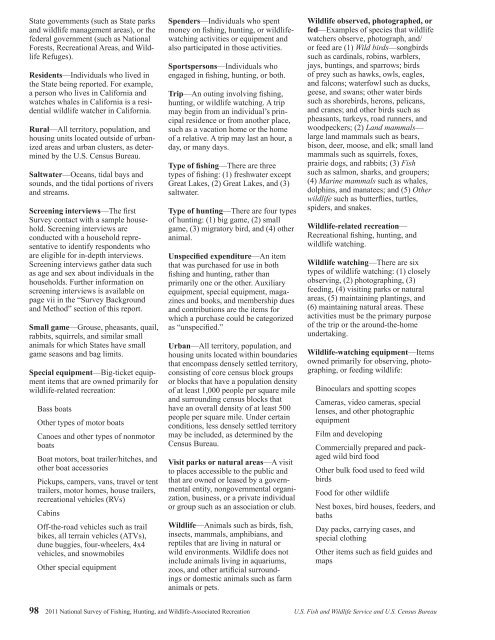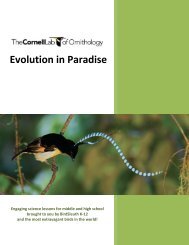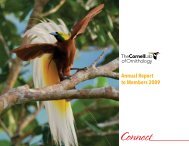National Survey of Fishing, Hunting, and Wildlife ... - All About Birds
National Survey of Fishing, Hunting, and Wildlife ... - All About Birds
National Survey of Fishing, Hunting, and Wildlife ... - All About Birds
You also want an ePaper? Increase the reach of your titles
YUMPU automatically turns print PDFs into web optimized ePapers that Google loves.
State governments (such as State parks<strong>and</strong> wildlife management areas), or thefederal government (such as <strong>National</strong>Forests, Recreational Areas, <strong>and</strong> <strong>Wildlife</strong>Refuges).Residents—Individuals who lived inthe State being reported. For example,a person who lives in California <strong>and</strong>watches whales in California is a residentialwildlife watcher in California.Rural—<strong>All</strong> territory, population, <strong>and</strong>housing units located outside <strong>of</strong> urbanizedareas <strong>and</strong> urban clusters, as determinedby the U.S. Census Bureau.Saltwater—Oceans, tidal bays <strong>and</strong>sounds, <strong>and</strong> the tidal portions <strong>of</strong> rivers<strong>and</strong> streams.Screening interviews—The first<strong>Survey</strong> contact with a sample household.Screening interviews areconducted with a household representativeto identify respondents whoare eligible for in-depth interviews.Screening interviews gather data suchas age <strong>and</strong> sex about individuals in thehouseholds. Further information onscreening interviews is available onpage vii in the “<strong>Survey</strong> Background<strong>and</strong> Method” section <strong>of</strong> this report.Small game—Grouse, pheasants, quail,rabbits, squirrels, <strong>and</strong> similar smallanimals for which States have smallgame seasons <strong>and</strong> bag limits.Special equipment—Big-ticket equipmentitems that are owned primarily forwildlife-related recreation:Bass boatsOther types <strong>of</strong> motor boatsCanoes <strong>and</strong> other types <strong>of</strong> nonmotorboatsBoat motors, boat trailer/hitches, <strong>and</strong>other boat accessoriesPickups, campers, vans, travel or tenttrailers, motor homes, house trailers,recreational vehicles (RVs)CabinsOff-the-road vehicles such as trailbikes, all terrain vehicles (ATVs),dune buggies, four-wheelers, 4x4vehicles, <strong>and</strong> snowmobilesOther special equipmentSpenders—Individuals who spentmoney on fishing, hunting, or wildlifewatchingactivities or equipment <strong>and</strong>also participated in those activities.Sportspersons—Individuals whoengaged in fishing, hunting, or both.Trip—An outing involving fishing,hunting, or wildlife watching. A tripmay begin from an individual’s principalresidence or from another place,such as a vacation home or the home<strong>of</strong> a relative. A trip may last an hour, aday, or many days.Type <strong>of</strong> fishing—There are threetypes <strong>of</strong> fishing: (1) freshwater exceptGreat Lakes, (2) Great Lakes, <strong>and</strong> (3)saltwater.Type <strong>of</strong> hunting—There are four types<strong>of</strong> hunting: (1) big game, (2) smallgame, (3) migratory bird, <strong>and</strong> (4) otheranimal.Unspecified expenditure—An itemthat was purchased for use in bothfishing <strong>and</strong> hunting, rather thanprimarily one or the other. Auxiliaryequipment, special equipment, magazines<strong>and</strong> books, <strong>and</strong> membership dues<strong>and</strong> contributions are the items forwhich a purchase could be categorizedas “unspecified.”Urban—<strong>All</strong> territory, population, <strong>and</strong>housing units located within boundariesthat encompass densely settled territory,consisting <strong>of</strong> core census block groupsor blocks that have a population density<strong>of</strong> at least 1,000 people per square mile<strong>and</strong> surrounding census blocks thathave an overall density <strong>of</strong> at least 500people per square mile. Under certainconditions, less densely settled territorymay be included, as determined by theCensus Bureau.Visit parks or natural areas—A visitto places accessible to the public <strong>and</strong>that are owned or leased by a governmentalentity, nongovernmental organization,business, or a private individualor group such as an association or club.<strong>Wildlife</strong>—Animals such as birds, fish,insects, mammals, amphibians, <strong>and</strong>reptiles that are living in natural orwild environments. <strong>Wildlife</strong> does notinclude animals living in aquariums,zoos, <strong>and</strong> other artificial surroundingsor domestic animals such as farmanimals or pets.<strong>Wildlife</strong> observed, photographed, orfed—Examples <strong>of</strong> species that wildlifewatchers observe, photograph, <strong>and</strong>/or feed are (1) Wild birds—songbirdssuch as cardinals, robins, warblers,jays, buntings, <strong>and</strong> sparrows; birds<strong>of</strong> prey such as hawks, owls, eagles,<strong>and</strong> falcons; waterfowl such as ducks,geese, <strong>and</strong> swans; other water birdssuch as shorebirds, herons, pelicans,<strong>and</strong> cranes; <strong>and</strong> other birds such aspheasants, turkeys, road runners, <strong>and</strong>woodpeckers; (2) L<strong>and</strong> mammals—large l<strong>and</strong> mammals such as bears,bison, deer, moose, <strong>and</strong> elk; small l<strong>and</strong>mammals such as squirrels, foxes,prairie dogs, <strong>and</strong> rabbits; (3) Fishsuch as salmon, sharks, <strong>and</strong> groupers;(4) Marine mammals such as whales,dolphins, <strong>and</strong> manatees; <strong>and</strong> (5) Otherwildlife such as butterflies, turtles,spiders, <strong>and</strong> snakes.<strong>Wildlife</strong>-related recreation—Recreational fishing, hunting, <strong>and</strong>wildlife watching.<strong>Wildlife</strong> watching—There are sixtypes <strong>of</strong> wildlife watching: (1) closelyobserving, (2) photographing, (3)feeding, (4) visiting parks or naturalareas, (5) maintaining plantings, <strong>and</strong>(6) maintaining natural areas. Theseactivities must be the primary purpose<strong>of</strong> the trip or the around-the-homeundertaking.<strong>Wildlife</strong>-watching equipment—Itemsowned primarily for observing, photographing,or feeding wildlife:Binoculars <strong>and</strong> spotting scopesCameras, video cameras, speciallenses, <strong>and</strong> other photographicequipmentFilm <strong>and</strong> developingCommercially prepared <strong>and</strong> packagedwild bird foodOther bulk food used to feed wildbirdsFood for other wildlifeNest boxes, bird houses, feeders, <strong>and</strong>bathsDay packs, carrying cases, <strong>and</strong>special clothingOther items such as field guides <strong>and</strong>maps98 2011 <strong>National</strong> <strong>Survey</strong> <strong>of</strong> <strong>Fishing</strong>, <strong>Hunting</strong>, <strong>and</strong> <strong>Wildlife</strong>-Associated Recreation U.S. Fish <strong>and</strong> <strong>Wildlife</strong> Service <strong>and</strong> U.S. Census Bureau






